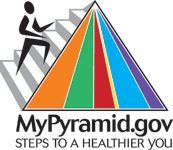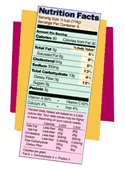| |
 |
Heart
Health Home > Healthy Lifestyles
| Healthy
Lifestyles |
| |
| About
Healthy Lifestyles
Choosing a healthy lifestyle can help you improve your health and reduce your risk
of heart disease and diabetes.
Healthy lifestyles include eating a healthy diet, maintaining
a healthy weight, exercising regularly, quitting
smoking (or not starting), and minimizing stress. (Note: Specific guidance for
maintaining a healthy lifestyle may change over time as new
scientific recommendations become available.)
Learn more about each of the factors that affect your lifestyle
by using the links below.
Back
to Top |

|
Eat a Healthy Diet
The Dietary
Guidelines for Americans show how good dietary habits
can promote health and reduce risk for major chronic diseases.
A heart-healthy diet is one that is:
- nutritious and well-balanced
- low in saturated fat, trans fat,
cholesterol, and salt
- high in fruits, vegetables, and whole grains
The Food Guide Pyramid and the Food Label are tools
to help consumers make informed food choices in the
context of a healthy diet.
Use the Food
Guide Pyramid to help you choose healthy foods each
day.
|
 |
Use the Food
Label Nutrition Facts Panel on the food products
you buy for guidance. In general, try to plan your daily
food choices so that you eat
- less than 100% of the Daily Value
(DV) for total fat, saturated fat, cholesterol, and
sodium.
- at least 100% of the Daily Value
(DV) for fiber, calcium, vitamin A, vitamin C, and
iron.
For more information on eating a healthy diet, see:
|
 |
Back
to Top |

|
Maintain a Healthy
Weight
Excess body fat leads to health problems such as type 2 diabetes,
high blood pressure, and high cholesterol.
Health professionals use a measurement called body mass index
(BMI) to classify an adult's weight as healthy, overweight,
or obese. BMI describes body weight relative to height and
is correlated with total body fat content in most adults.
To find your BMI, use the chart on this page or
National
Heart Lung and Blood Institute's BMI calculator.
BMI range:
- 18.5-25 -- healthy range
- 25-30 - overweight
- 30 or higher -- obese
Having excess abdominal body fat is also a health risk. Men
with a waist of more than 40 inches around and women with
a waist of 35 inches or more are at risk for health problems.
More than 60 percent of U.S. adults are either overweight or obese, according to the Centers for Disease Control and Prevention (CDC). While the number of overweight people has been slowly climbing since the 1980s, the number of obese adults has nearly doubled since then.
Excess weight and physical inactivity account for more than 300,000 premature deaths each year in the United States, second only to deaths related to smoking, says the CDC. People who are overweight or obese are more likely to develop heart disease, stroke, high blood pressure, diabetes, gallbladder disease and joint pain caused by excess uric acid (gout). Excess weight can also cause interrupted breathing during sleep (sleep apnea) and wearing away of the joints (osteoarthritis).
To lose weight, you must eat less and move more. Your body
needs to burn more calories than you take in.
For more information on losing weight, see:
Back
to Top |

|
Exercise Regularly
Exercise improves heart function, lowers blood pressure and
blood cholesterol, helps manage diabetes, and helps control
weight.
The National Heart, Lung, and Blood Institute (NHLBI) at
NIH recommends that adults get at least 30 minutes of moderate
physical activity on most days of the week.
Talk to your doctor about what forms of exercise are best
for you.
For more information about exercise and physical fitness,
see:
- Exercise
and Physical Fitness
MedlinePlus Health Information
http://www.nlm.nih.gov/medlineplus/exerciseandphysicalfitness.html
- Physical
Activity
CDC Division of Nutrition and Physical Activity
http://www.cdc.gov/nccdphp/dnpa/physical/index.htm
Back
to Top |

|
Quit or Do Not Start
Smoking
Smoking cigarettes significantly increases
your risk of coronary heart disease.
Facts about smoking and coronary heart disease:
- Tobacco smoke increases your risk or atherosclerosis.
- Smokers have more than twice the risk of
having a heart attack as non-smokers.
- Smoking is the biggest risk factor for
sudden cardiac death.
- Smokers who have a heart attack are more
likely to die than non-smokers who have a heart attack.
In the first year that you stop smoking, your risk of coronary
heart disease drops sharply. In time, your risk will gradually
return to that of someone who has never smoked.
For information on quitting smoking, see:
Back
to Top |

|
Minimize Stress
The link between stress and coronary heart disease is not
entirely clear. However, people who have too much stress or
who have unhealthy responses to stress may be at greater risk
of having coronary heart disease.
Facts about stress and coronary heart disease:
- Stress speeds up the heart rate.
- People with heart disease are more likely
to have a heart attack during times of stress.
- People sometimes respond to stress with
unhealthy habits such as smoking or eating salty or high-fat
foods.
For information on stress reduction, see:
Back
to Top |
|



